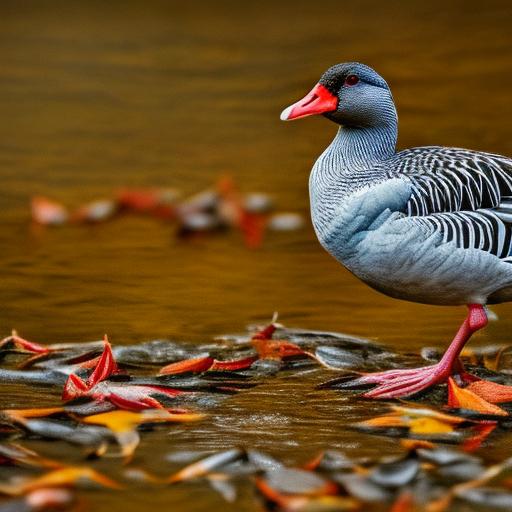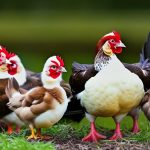Geese are large waterfowl that are known for their distinctive honking sound and V-shaped flying formation. They are found in various parts of the world, including North America, Europe, and Asia. Geese are highly social animals and often form large flocks, known as gaggles, which can consist of hundreds or even thousands of individuals.
Geese are herbivores and primarily feed on grasses, grains, and aquatic plants. They are also known to graze on lawns and crops, which can be problematic in certain areas. Geese are adaptable birds and can thrive in a variety of habitats, including urban areas, parks, golf courses, and agricultural fields.
Key Takeaways
- Geese are social birds that mate for life and can live up to 25 years.
- Geese can become a problem in certain areas due to their droppings and aggressive behavior.
- Cayenne pepper can be used as a natural deterrent for geese.
- Cayenne pepper irritates the geese’s eyes and respiratory system, causing them to avoid the area.
- To use cayenne pepper as a deterrent, sprinkle it around the area or mix it with water and spray it on surfaces.
The problem of geese in certain areas
While geese can be a beautiful sight to behold, they can also be a nuisance in certain areas. One of the main issues with geese is their droppings. Geese produce a large amount of feces, which can create unsightly messes on sidewalks, lawns, and other public spaces. Not only is this unpleasant to look at, but it can also pose health risks as goose droppings can contain harmful bacteria.
In addition to the mess they create, geese can also cause damage to property and the environment. Their constant grazing can destroy lawns and crops, leading to financial losses for homeowners and farmers. Geese can also damage natural habitats by overgrazing on vegetation and disturbing nesting sites for other bird species.
The use of cayenne pepper as a deterrent
One popular method for deterring geese from certain areas is the use of cayenne pepper. Cayenne pepper is a spice derived from dried chili peppers and is known for its spicy taste. It contains a compound called capsaicin, which gives it its heat.
When used as a deterrent, cayenne pepper works by irritating the geese’s senses. Geese have a highly developed sense of smell, and the strong scent of cayenne pepper can be overwhelming for them. Additionally, the spicy taste of cayenne pepper can cause discomfort when ingested by geese.
How cayenne pepper affects geese
The use of cayenne pepper as a deterrent can have both physical and psychological effects on geese. Physically, the strong scent of cayenne pepper can irritate the geese’s nasal passages, making it unpleasant for them to be in the area. The spicy taste of cayenne pepper can also cause discomfort when ingested by geese, leading them to avoid areas where it has been applied.
Psychologically, the presence of cayenne pepper can create a negative association for geese. They learn to associate the unpleasant experience of encountering cayenne pepper with certain areas and will avoid those areas in the future. This creates a deterrent effect that can help keep geese away from unwanted areas.
How to use cayenne pepper to keep geese away
Using cayenne pepper as a deterrent for geese is relatively simple and cost-effective. Here are some step-by-step instructions for using cayenne pepper:
1. Identify the areas where you want to keep geese away. This could be your lawn, garden, or any other area where geese are causing problems.
2. Purchase cayenne pepper powder from a local grocery store or garden center. Make sure to choose a high-quality product that is free from additives or preservatives.
3. Sprinkle a generous amount of cayenne pepper powder in the areas where you want to deter geese. Focus on areas where they are likely to graze or congregate.
4. Reapply the cayenne pepper powder regularly, especially after rain or heavy watering, as it can wash away over time.
Precautions to take when using cayenne pepper

While cayenne pepper is generally safe to use as a deterrent for geese, there are some precautions you should take to ensure the safety of other animals and people. Here are some safety tips for handling and applying cayenne pepper:
1. Wear gloves and avoid touching your face or eyes when handling cayenne pepper powder. The capsaicin in cayenne pepper can cause irritation and burning sensations.
2. Keep cayenne pepper out of reach of children and pets. While it is not toxic, ingesting large amounts of cayenne pepper can cause digestive upset.
3. Avoid applying cayenne pepper directly to plants or crops that you intend to consume. While it is generally safe for plants, the spicy taste of cayenne pepper can transfer to the produce and make it unpleasant to eat.
4. Consider using a barrier method, such as a mesh or netting, to prevent geese from accessing certain areas. This can be used in conjunction with cayenne pepper to create a more effective deterrent.
Alternatives to cayenne pepper for deterring geese
While cayenne pepper is a popular choice for deterring geese, there are other natural and humane methods that can be effective as well. Here are some alternatives to consider:
1. Reflective tape or scare devices: Geese are wary of shiny or moving objects, so hanging reflective tape or using scare devices like windsocks or pinwheels can help deter them.
2. Ultrasonic devices: These emit high-frequency sounds that are unpleasant to geese but inaudible to humans. They can be effective in keeping geese away from certain areas.
3. Habitat modification: Making changes to the environment, such as removing food sources or altering landscaping, can make an area less attractive to geese.
4. Border collies or trained dogs: These herding dogs can be trained to chase geese away from certain areas. Their presence alone can be enough to deter geese from settling in an area.
Other methods for managing geese populations
While deterrent methods can help keep geese away from certain areas, it is important to address the root cause of the problem to effectively manage geese populations in the long term. Here are some long-term solutions for reducing the number of geese in an area:
1. Egg addling: This involves shaking or coating goose eggs with oil to prevent them from hatching. By reducing the number of new goslings, the overall population can be controlled.
2. Habitat management: Creating or enhancing natural habitats for other bird species can help reduce competition for resources and discourage geese from settling in an area.
3. Public education: Raising awareness about the negative impacts of feeding geese and encouraging responsible behavior can help reduce human-goose conflicts.
4. Population control: In some cases, culling or relocating geese may be necessary to manage populations that have become too large or are causing significant damage.
The effectiveness of cayenne pepper as a long-term solution
While cayenne pepper can be an effective short-term solution for deterring geese, its long-term effectiveness may vary depending on various factors. These factors include the size of the goose population, the availability of alternative food sources, and the overall habitat conditions.
In areas with a large and established goose population, cayenne pepper alone may not be enough to completely eliminate the problem. Geese are highly adaptable and may learn to tolerate or avoid areas where cayenne pepper has been applied over time.
To achieve long-term success, it is important to combine the use of cayenne pepper with other management strategies, such as habitat modification or population control. This multi-faceted approach can help create a more sustainable solution for managing geese populations.
Conclusion and final thoughts on using cayenne pepper to keep geese away
In conclusion, cayenne pepper can be a useful tool for deterring geese from certain areas. Its strong scent and spicy taste can create an unpleasant experience for geese, leading them to avoid areas where it has been applied. However, it is important to remember that cayenne pepper is not a standalone solution and should be used in conjunction with other management strategies for long-term success.
When using cayenne pepper, it is crucial to take precautions to ensure the safety of other animals and people. Handling cayenne pepper with gloves and avoiding contact with the face or eyes is important. Additionally, considering alternative deterrent methods and addressing the root cause of the problem are essential for effectively managing geese populations.
By taking a holistic and humane approach, we can strike a balance between coexisting with geese and minimizing the negative impacts they can have on our environment and property.
If you’re looking for effective ways to keep geese away from your property, you might be interested in this informative article on Poultry Wizard. They discuss the use of cayenne pepper as a natural deterrent for geese. Cayenne pepper is known for its strong scent and taste, which can be unpleasant for geese and discourage them from lingering in your area. To learn more about this method and other tips for keeping geese away, check out the article here. And while you’re at it, don’t forget to explore their other helpful articles on topics such as choosing the best coop for your chickens (link) and finding the right heater for your chicken coop (link). Happy reading and happy goose-free property!
FAQs
What is cayenne pepper?
Cayenne pepper is a type of chili pepper that is commonly used in cooking. It is known for its spicy flavor and is often used to add heat to dishes.
How does cayenne pepper keep geese away?
Cayenne pepper is believed to be an effective deterrent for geese because they do not like the taste or smell of it. When sprinkled around an area where geese are known to gather, the pepper can discourage them from returning.
Is cayenne pepper harmful to geese?
Cayenne pepper is not harmful to geese, but it can cause discomfort if they come into contact with it. It is important to use the pepper sparingly and avoid getting it in their eyes or on their skin.
How do I use cayenne pepper to keep geese away?
To use cayenne pepper as a deterrent for geese, simply sprinkle it around the area where they are known to gather. Be sure to reapply the pepper after rain or wind, as it can be easily washed away.
Are there any other methods for keeping geese away?
Yes, there are several other methods for keeping geese away, including using decoys, installing fencing, and using noise deterrents. It is important to choose a method that is safe and effective for both the geese and the surrounding environment.
Meet Walter, the feathered-friend fanatic of Florida! Nestled in the sunshine state, Walter struts through life with his feathered companions, clucking his way to happiness. With a coop that’s fancier than a five-star hotel, he’s the Don Juan of the chicken world. When he’s not teaching his hens to do the cha-cha, you’ll find him in a heated debate with his prized rooster, Sir Clucks-a-Lot. Walter’s poultry passion is no yolk; he’s the sunny-side-up guy you never knew you needed in your flock of friends!







